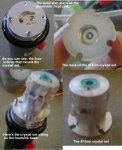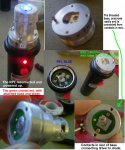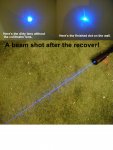
Welcome to Laser Pointer Forums - discuss green laser pointers, blue laser pointers, and all types of lasers
How to Register on LPF | LPF Donations
Navigation
Install the app
How to install the app on iOS
Follow along with the video below to see how to install our site as a web app on your home screen.
Note: This feature may not be available in some browsers.
More options

You are using an out of date browser. It may not display this or other websites correctly.
You should upgrade or use an alternative browser.
You should upgrade or use an alternative browser.
Replacing the LD on my RPL...
- Thread starter Ace82
- Start date


brtaman
0
- Joined
- Jun 12, 2008
- Messages
- 1,199
- Points
- 48
Yeah it would be kind of weird for the diode (especially a tough one), to be the first thing to go bust on impact, imo?
Hope you get it fixed asap...
brtaman
Hope you get it fixed asap...
brtaman
brtaman said:Yeah it would be kind of weird for the diode (especially a tough one), to be the first thing to go bust on impact, imo?
Hope you get it fixed asap...
brtaman
Oh I will! It seems equally as difficult to align as the green, just a little harder because it is so sensitive to heat. I need to let it cool so I can get it in TEM00, as it is running in TEM02 because it's so warm, plus I'm sure my fingers on the heat sink isn't really helping. But it's on the way! I'll post some pictures in a while, but first I need to get it aligned. I never even needed to crack it, if I would have known before, the entire thing comes out of the handle!
GooeyGus
0
- Joined
- Mar 8, 2008
- Messages
- 2,669
- Points
- 48
The reason it says '20' inside, is because many times a supplier will order a 20mW from the manufacturer (the manufacturer builds it on request, with parts that should make at least 20mW) but when tested the output is actually a bit more, so you can sell it advertising a higher avg. power, because it does have a higher power. For example, climbak just ordered a 500mW 532nm labby from CNI. They built it, put it together, and it does around 575mW average. If he were a reseller he could sell it as a 550mW model and get some more cash.
Now don't take this as gospel, but many resellers do it this way.
Now don't take this as gospel, but many resellers do it this way.
- Joined
- Oct 24, 2006
- Messages
- 2,032
- Points
- 38
Indeed. These units are manufactured as more than 20mW in blue, or 300mW in green but varying crystal efficiencies and qualities can change things a bit. The only thing is that when a seller guarantees a higher mW value, they have the responsibility of providing service for the laser at that power whereas the manufacturer is only responsible for the original level. So the seller can easily get stuck with a pretty hard liability there.
GooeyGus said:The reason it says '20' inside, is because many times a supplier will order a 20mW from the manufacturer (the manufacturer builds it on request, with parts that should make at least 20mW) but when tested the output is actually a bit more, so you can sell it advertising a higher avg. power, because it does have a higher power. For example, climbak just ordered a 500mW 532nm labby from CNI. They built it, put it together, and it does around 575mW average. If he were a reseller he could sell it as a 550mW model and get some more cash.
Now don't take this as gospel, but many resellers do it this way.
That's exactly what I assumed.
Petrovski said:Ah good to hear it turned out to be a relatively easy fix! Nice pictures, I always wondered what an RPL looked like from the inside. How much time did it take you to get the crystal set aligned? Is there a special method for that?
It took about 10min. No real 'special' method, as it's easier on the eyes being lower powered, its easy to tell when you got it by very slight shifts x & y until you get a perfect clean, bright circle, then you know you have it! The green is a little harder, I wear sunglasses because its really bright, and with the goggles you can't even see it uncollimated. I hope I didn't expose any secrets... :-X...
Attachments
D
Deleted member 13229
Guest
I'm glad you got it fixed, but for some reason I remember reading that a crystal in the 473nm process is pretty hygroscopic, can anybody confirm this?
styropyro said:I'm glad you got it fixed, but for some reason I remember reading that a crystal in the 473nm process is pretty hygroscopic, can anybody confirm this?
Cant say I can...
Hygroscopy is the ability of a substance to attract water molecules from the surrounding environment through either absorption or adsorption.
Hygroscopic substances include honey, glycerol, ethanol, methanol, concentrated sulfuric acid, methamphetamine, iodine[1], and concentrated sodium hydroxide (lye). Calcium chloride is so hygroscopic that it eventually dissolves in the water it absorbs: this property is called deliquescence (see below). Because of their affinity for atmospheric moisture, hygroscopic materials may need to be stored in sealed containers. When added to foods or other materials for the express purpose of maintaining moisture content, such substances are known as humectants.
Materials and compounds exhibit different hygroscopic properties, and this difference can lead to detrimental effects, such as stress concentration in composite materials. The amount a particular material or compound is affected by ambient moisture may be considered its coefficient of hygroscopic expansion (CHE) (also referred to as CME, coefficient of moisture expansion) or coefficient of hygroscopic contraction (CHC)—the difference between the two terms being a difference in sign convention and a difference in point of view as to whether the difference in moisture leads to contraction or expansion.
A common example where difference in this hygroscopic property can be seen is in a paperback book cover. Often, in a relatively moist environment, the book cover will curl away from the rest of the book. The unlaminated side of the cover absorbs more moisture than the laminated side and increases in area, causing a stress that curls the cover toward the laminated side. This is similar to the function of a bi-metallic strip. Inexpensive gauge-type hygrometers frequently seen domestically make use of this principle.
The similar-sounding but unrelated word hydroscopic is sometimes used in error for hygroscopic. A hydroscope is an optical device used for making observations deep under water.
Sorry, I personally have no idea.
diachi
0
- Joined
- Feb 22, 2008
- Messages
- 9,700
- Points
- 113
Thats great you got it fixed , shame your friends friend is already dead ... 
Did jack get back to you about the under spec green ?
Diachi
Did jack get back to you about the under spec green ?
Diachi





